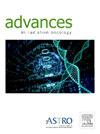乳腺癌细胞暴露于x射线或高能碳离子后细胞质dsDNA和cGAS-STING免疫信号的诱导
IF 2.7
Q3 ONCOLOGY
引用次数: 0
摘要
目的:放射治疗可通过细胞质dsDNA片段诱导激活环GMP-AMP合成酶(cGAS)-干扰素基因刺激因子(STING)轴。cGAS-STING的激活启动由干扰素I型介导的先天免疫信号传导,有助于根除恶性肿瘤。结果表明,这种效果取决于所采用的分馏方案。我们假设先天免疫反应也可能依赖于辐射质量,因为密集电离辐射,如碳离子,对DNA损伤质量有不同的影响。方法和材料我们将体外4T1乳腺癌模型暴露于光子或碳离子下,用集落形成实验测量细胞的克隆成活。细胞内dsDNA片段的出现采用免疫荧光法,干扰素β的表达和释放采用定量逆转录聚合酶链反应和酶联免疫吸附法。大量RNA测序用于研究辐射引起的基因表达的整体变化。结果与光子相比,碳离子诱导的单位剂量胞质dsDNA片段的产量明显更高。更高的效率也体现在肿瘤细胞的干扰素-β的表达和释放上。细胞质dsDNA聚焦率和干扰素β释放率随剂量增加而增加,并且与单次高剂量(20或24 Gy)光子相比,分离方案(3 × 8 Gy)没有差异。结论辐照后干扰素β的释放随着辐照剂量的增加而增加,且碳离子具有引发强先天免疫信号的潜力。本文章由计算机程序翻译,如有差异,请以英文原文为准。
Induction of Cytoplasmic dsDNA and cGAS-STING Immune Signaling After Exposure of Breast Cancer Cells to X-ray or High-Energetic Carbon Ions
Purpose
Radiation therapy can trigger activation of the cyclic GMP-AMP synthase (cGAS)- Stimulator of interferon genes (STING) axis via cytoplasmic dsDNA fragment induction. The activation of cGAS-STING initiates innate immune signaling mediated by interferon type I that can contribute to eradicate the malignancy. The effect was shown to depend on the fractionation scheme employed. We hypothesized that the innate immune response can also depend on radiation quality because densely ionizing radiation, such as carbon ions, have different effects on DNA lesion quality.
Methods and Materials
We exposed an in vitro 4T1 breast cancer model to either photons or carbon ions and measured the clonogenic survival of cells with the colony-forming assay. The occurrence of cytosolic dsDNA fragments was assessed via immunofluorescence, whereas the expression and release of interferon-β by quantitative reverse transcription polymerase chain reaction and enzyme-linked immunosorbent assay. Bulk RNA sequencing was used to investigate global radiation-induced changes in gene expression.
Results
We show here that carbon ions induced a significantly higher yield of cytosolic dsDNA fragments per unit dose as compared to photons. The higher efficiency also translated in expression and release of interferon-β by the tumor cells. The rate of cytoplasmic dsDNA foci as well as interferon-β release increased with doses up to 20 Gy and no differences for a fractionation scheme (3 × 8 Gy) were found as compared to the single high doses (20 or 24 Gy) of photons.
Conclusions
In conclusion, we found that the release of interferon-β after radiation increases with the radiation dose up to 20 Gy and that carbon ions have the potential to elicit a strong innate immune signaling.
求助全文
通过发布文献求助,成功后即可免费获取论文全文。
去求助
来源期刊

Advances in Radiation Oncology
Medicine-Radiology, Nuclear Medicine and Imaging
CiteScore
4.60
自引率
4.30%
发文量
208
审稿时长
98 days
期刊介绍:
The purpose of Advances is to provide information for clinicians who use radiation therapy by publishing: Clinical trial reports and reanalyses. Basic science original reports. Manuscripts examining health services research, comparative and cost effectiveness research, and systematic reviews. Case reports documenting unusual problems and solutions. High quality multi and single institutional series, as well as other novel retrospective hypothesis generating series. Timely critical reviews on important topics in radiation oncology, such as side effects. Articles reporting the natural history of disease and patterns of failure, particularly as they relate to treatment volume delineation. Articles on safety and quality in radiation therapy. Essays on clinical experience. Articles on practice transformation in radiation oncology, in particular: Aspects of health policy that may impact the future practice of radiation oncology. How information technology, such as data analytics and systems innovations, will change radiation oncology practice. Articles on imaging as they relate to radiation therapy treatment.
 求助内容:
求助内容: 应助结果提醒方式:
应助结果提醒方式:


